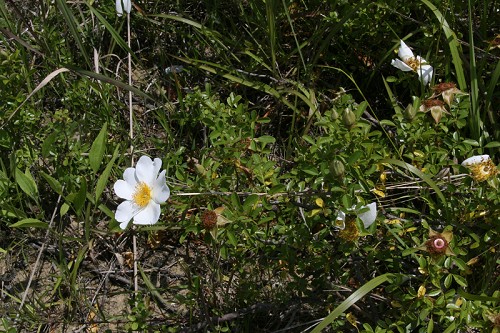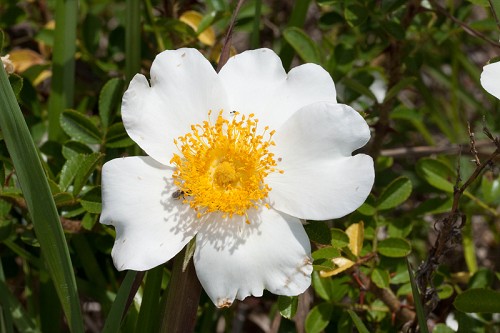Difference between revisions of "Rosa bracteata"
| Line 20: | Line 20: | ||
Common name: Macartney rose, Chickasaw Rose | Common name: Macartney rose, Chickasaw Rose | ||
==Taxonomic notes== | ==Taxonomic notes== | ||
| + | Rosa bracteata was introduced to Europe in 1795, and later to the United States, where it became widely naturalized and invasive in parts of the southeast, and in the West Indies. The species forms dense thickets of puberulent to tomentose stems; bracts, pedicels, and hips are densely sericeo-tomentose. The six to eight bracts closely subtend the short pedicels and tightly cover about half or all of the hypanthia [http://www.efloras.org/florataxon.aspx?flora_id=1&taxon_id=200011225 The Flora of North America]. | ||
| + | |||
==Description== | ==Description== | ||
<!-- Basic life history facts such as annual/perrenial, monoecious/dioecious, root morphology, seed type, etc. --> | <!-- Basic life history facts such as annual/perrenial, monoecious/dioecious, root morphology, seed type, etc. --> | ||
Revision as of 16:46, 10 August 2016
| Rosa bracteata | |
|---|---|

| |
| Photo by John R. Gwaltney, Southeastern Flora.com | |
| Scientific classification | |
| Kingdom: | Plantae |
| Division: | Magnoliophyta - Flowering plants |
| Class: | Magnoliopsida – Dicotyledons |
| Order: | Rosales |
| Family: | Rosaceae |
| Genus: | Rosa |
| Species: | R. bracteata |
| Binomial name | |
| Rosa bracteata J.C. Wendl. | |

| |
| Natural range of Rosa bracteata from USDA NRCS Plants Database. | |
Common name: Macartney rose, Chickasaw Rose
Contents
Taxonomic notes
Rosa bracteata was introduced to Europe in 1795, and later to the United States, where it became widely naturalized and invasive in parts of the southeast, and in the West Indies. The species forms dense thickets of puberulent to tomentose stems; bracts, pedicels, and hips are densely sericeo-tomentose. The six to eight bracts closely subtend the short pedicels and tightly cover about half or all of the hypanthia The Flora of North America.
Description
A description of Rosa bracteata is provided in The Flora of North America.
Distribution
Ecology
Habitat
Phenology
Seed dispersal
Seed bank and germination
Fire ecology
Pollination
The following Hymenoptera families and species were observed visiting flowers of Rosa bracteata at Archbold Biological Station (Deyrup 2015):
Apidae: Bombus pennsylvanicus
Halictidae: Halictus poeyi, Lasioglossum coreopsis
Use by animals
Diseases and parasites
Conservation and Management
Cultivation and restoration
Photo Gallery
Flower of Rosa bracteata Photo by John R. Gwaltney, Southeastern Flora.com
References and notes
Deyrup, M.A. and N.D. 2015. Database of observations of Hymenoptera visitations to flowers of plants on Archbold Biological Station, Florida, USA.
